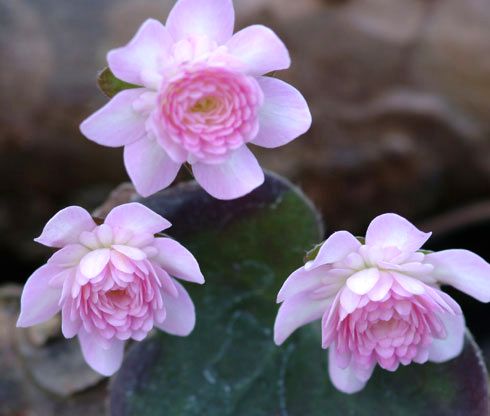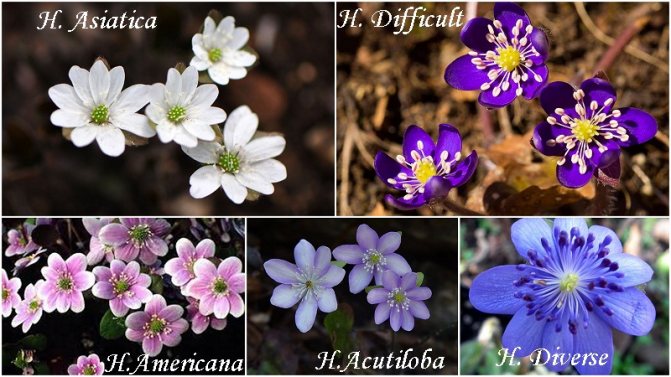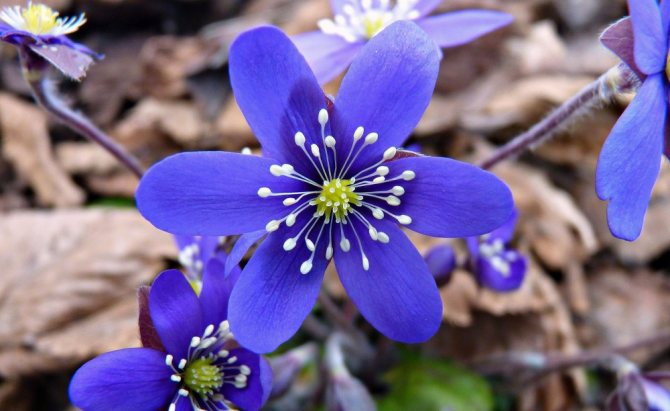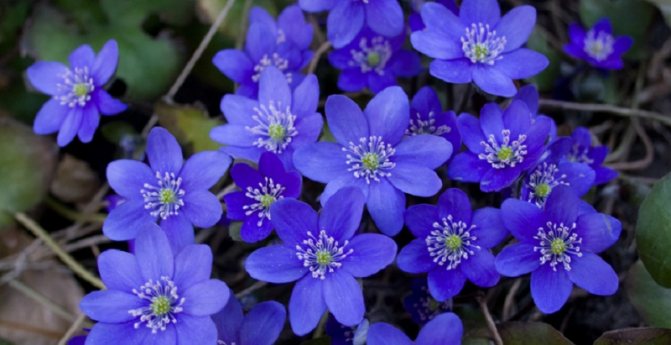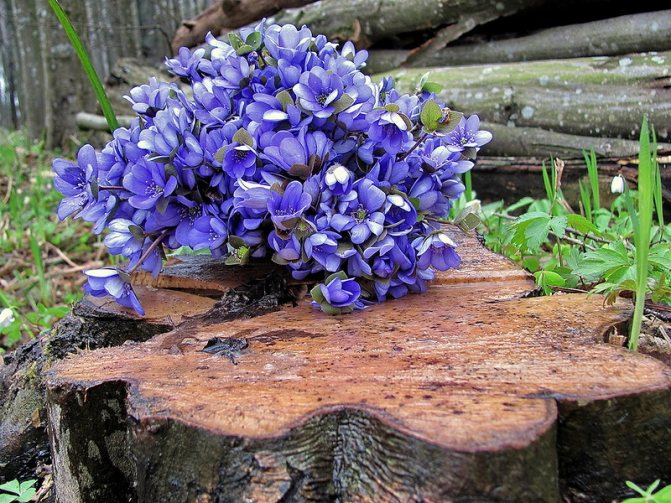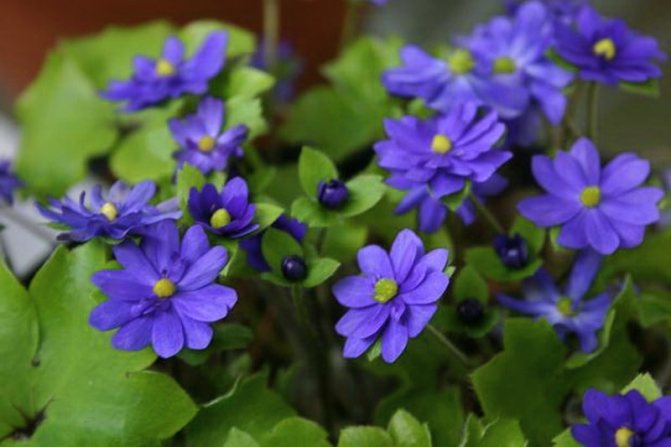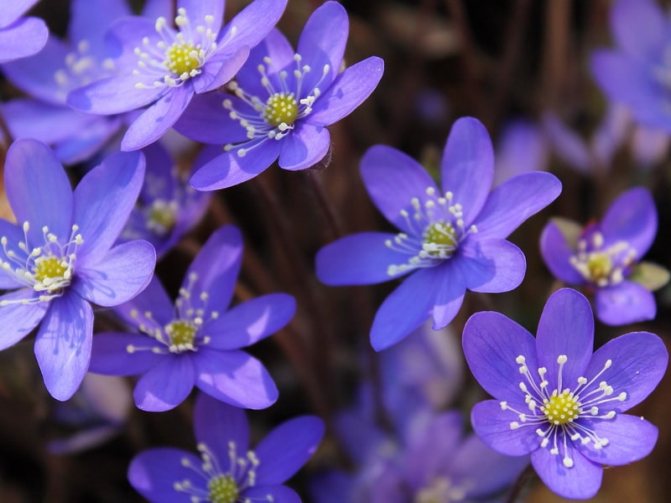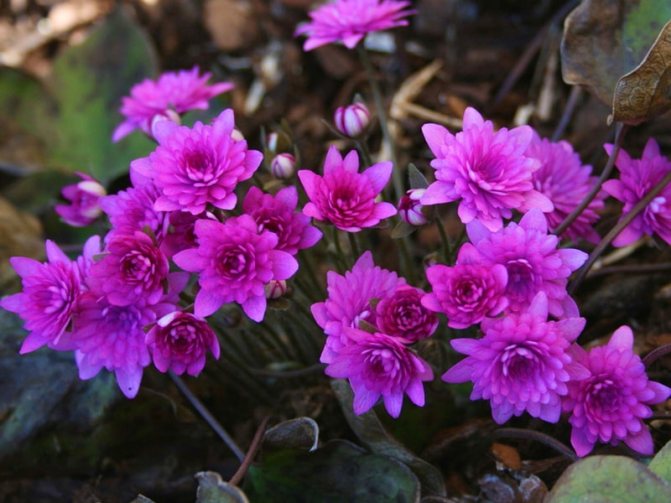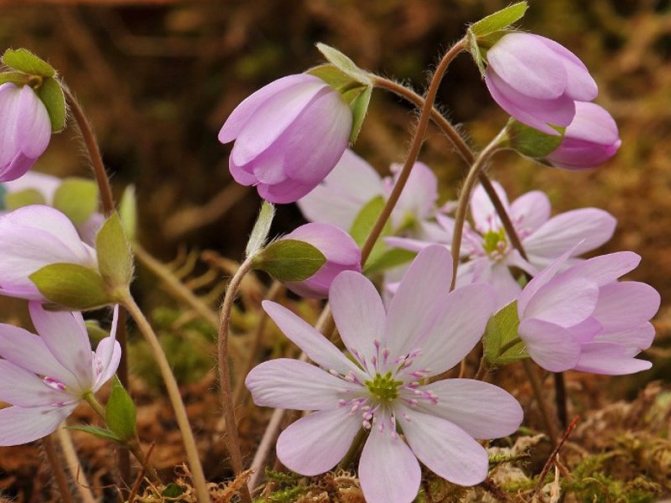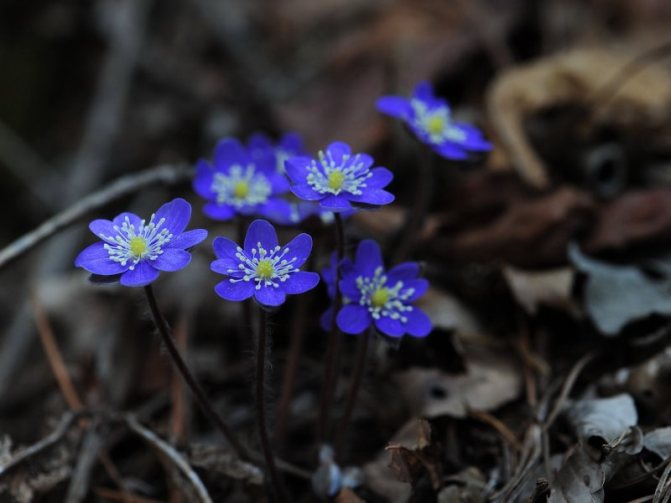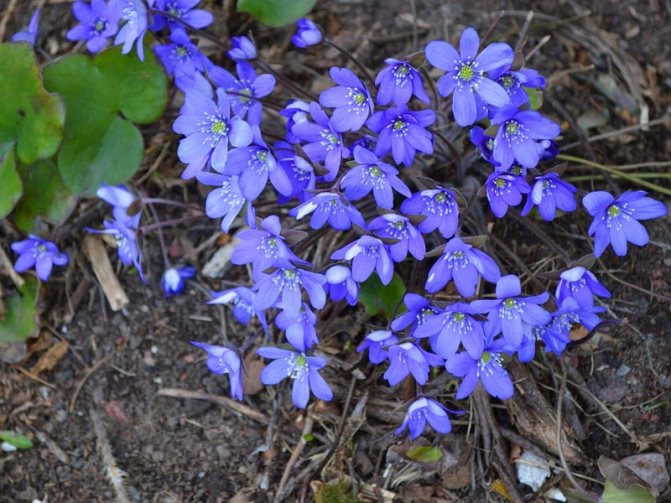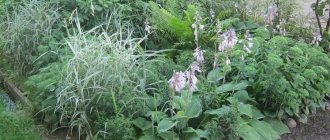In recent years, the popularity of the liverwort, or coppice, has greatly increased. The variety of varieties is huge - double forms, two-colored and even three-colored, with curly flowers, carved petals, as well as variegated foliage ...
First, I'll show you what a liverwort flower looks like. The genus is divided into two groups, which include seven species and ten varieties. A few of the main ones are discussed below.
Transylvanian liverwort (Hepatica transsilvanica). Grows on the territory of Romania. Features:
- five-lobed leaves,
- the flowers are large, there are varieties with white, pink, lilac and double flowers,
- increased winter hardiness.
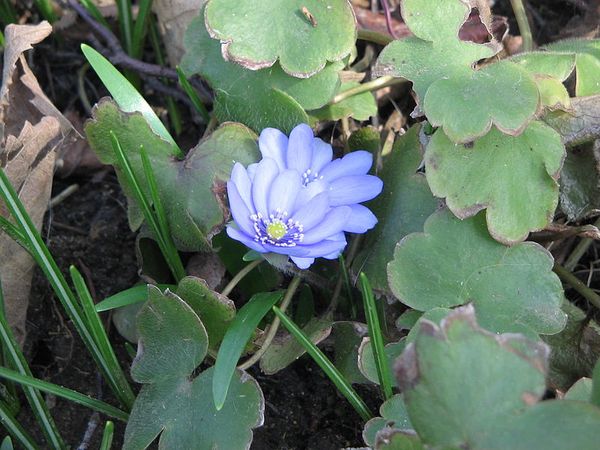
@Meneerke bloem, WikiMedia Commons
American liverwort (Hepatica americana). Originally from North America. It is different:
- leaves are leathery, cordate, three-lobed, slightly pubescent below,
- flowers are most often lilac, but there are white and pink,
- flowering time up to 20 days.


Photo by bobistraveling
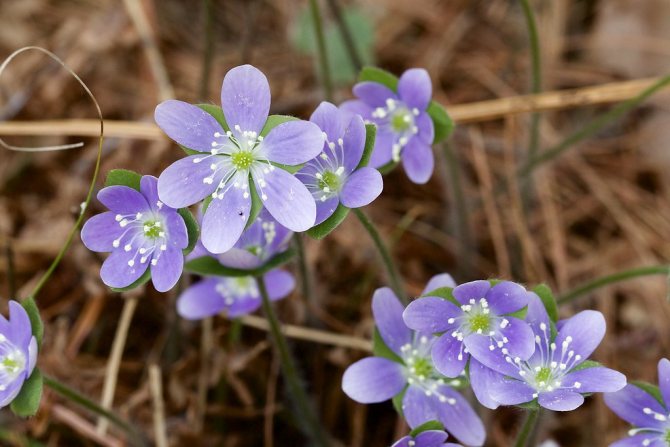

Photo by jmvdMaren
Asian liverwort (Hepatica nobilis var.asiatica). Grows in Primorye, China and Korea. Distinctive features of this type:
- marble pattern on the leaves, at the very beginning they have a brown-red color, the shape of the leaves is three-lobed, like that of the noble liverwort, but they are more delicate. With the onset of cold weather, they quickly turn yellow and die off.
- the flowers are white, there are forms with lilac, blue and pink flowers, with strokes and specks.
Grows rapidly and reproduces well by self-seeding. It blooms in April-May at the same time as the liverwort noble.


Photo by KHQ Flower Guide
Noble liverwort (Hepatica nobilis var.nobilis). Widespread in Europe. In culture, its natural forms with different colors are used - white, pale and bright pink, purple, and also terry. In nature, plants are found with speckled and shaded petals, with a border of a different color.
It is unpretentious and grows well.


Photo by sirispj
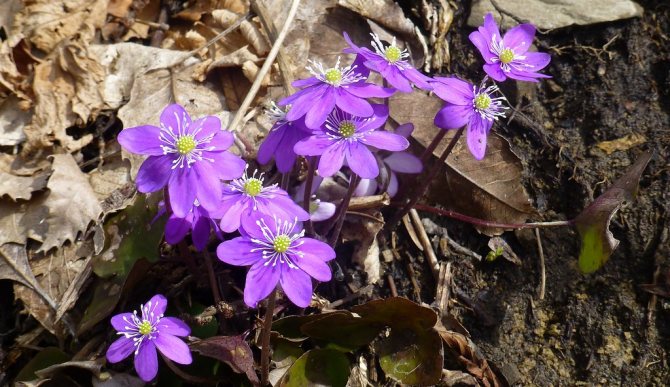

Photo by cristina.sanvito
Japanese liverwort (Hepatica japonica). Mainly grown in pot culture. However, there are varieties that winter well in the middle lane, but grow much more slowly.
Outstanding representatives: Raspberry-flowered Red Forest, Pink-lilac Pink Forest and White White Forest.
In Japan, the copse has become a cult plant, it is called Yukiwariso - a flower that breaks through the snow - and annual exhibitions of flowering liverworts are held. The number of varieties is amazing.
Variety of liverworts
The noble liverwort has many forms with pink, dark blue, purple and white flowers. A large number of varieties and hybrids were created on their basis. They differ:
- by the color of the stamens (yellow, pink),
- by the color of the petals, sometimes they are painted in two tones,
- flowers can be different in shape, size, number of petals,
- semi-double and terry,
- there are also varieties with original leaves - dark green, shiny, with dark strokes, with a corrugated edge.
Plants with interesting leaves are valued more because they survive and decorate the garden throughout the year. There are silvery leaves, with a cream or white edge, of irregular shape, reminiscent of marble or malachite (more often in the Japanese variety).
Location and soil selection
Despite the fact that the plant is reputed to be quite unpretentious, three important conditions must be met in order for it to settle in the garden for a long time:
- A shady place where it is always cool in hot weather. Liverwort is considered one of the most shade-tolerant cultures.
- The soil is rich in humus, calcareous, neutral or slightly acidic, as well as moist and well-drained.
- Mulching plantings.
Tree trunks are ideal - the flower has a shallow root system, so there will be no competition for food.
Some soil recommendations for selected species of copse.
| Variety | What will fit |
| Transylvanian | Heavier soils. |
| Asian | Will helpfully increase the amount of leafy land. |
| American | Loves fertile loose soil (neutral or slightly acidic). There should be no stagnation of water. |
| Noble | It grows in any soil, but it must be rich in lime. |
| Japanese one of the most capricious |
More often grown as a container culture. |
Other types of liverworm
In addition to the noble liverwort, there are the following types of plants:
Transylvanian liverwort (Heratika transilvanika), which is native to Eastern Europe and is distinguished by larger blue or purple flowers with more numerous petals and leaves with larger teeth.


The following species, depending on the classification, are either isolated separately, or classified as subspecies of the noble liverwort.
Asian liverwort (Heratika asiatica), according to different classifications, either allocated as a separate species, or belonging to the subspecies of the noble liverwort. It has white, pink and purple flowers. It grows in the Far East, Japan, China and Korea.
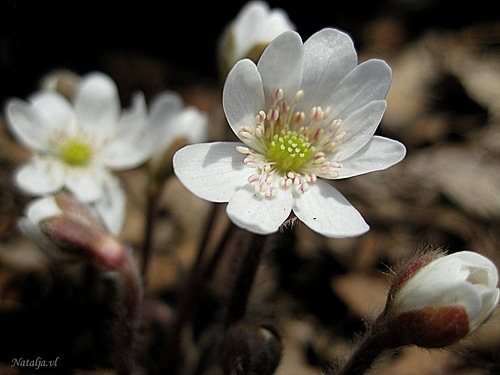

Pubescent liverwort (Heratika pubescens), has rounded variegated leaves.
Japanese liverwort (Heratika japonica). Differs in a wide variety of leaves and petals (from rounded to pointed), varying degrees of doubleness of flowers. In Japan, the liverwort is especially popular, it is there that its active selection is carried out.
Pubescent liverwort (Heratika pubescens). Has rounded leaves with streaks.
Liverworts sharp-lobed and dull (Heratika acutiloba, Heratika americana), native to America. The first has large deeply dissected leaves, and large flowers with pointed tips of the petals. The second is more miniature, with rounded petals and three-lobed leaves.
In the process of breeding work, a large group of hybrids was bred on the basis of crossing the Transylvanian liverwort with other species. They are combined under the name of the average liverwort (Heratika media). These hybrids have double flowers of blue, purple, pink and white shades and are distinguished by long flowering.
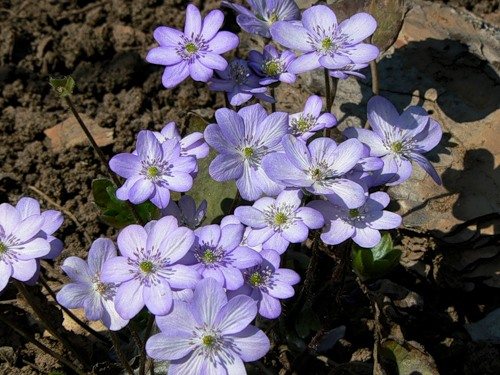

How and when to plant a liverwort
The best time to plant a liverwort is spring, after flowering, and from mid-August to September 10.
However, if necessary, you can move it to another place in the summer along with a lump of earth. In order for the plant to easily endure the procedure, it is important to shade it for the first weeks and water the soil well.
Plant collector Anna Rubinina also advises to spray the flower at this time with a solution of Bordeaux liquid (1%) for the prevention of fungal diseases, according to the instructions.
When planting, the root collar is not buried; the roots in the planting hole are placed vertically.
The copse can reproduce by self-seeding. But this is in the event that the seeds are not taken away by the ants. In addition, when they dry, they lose their germination.
Growing from seeds
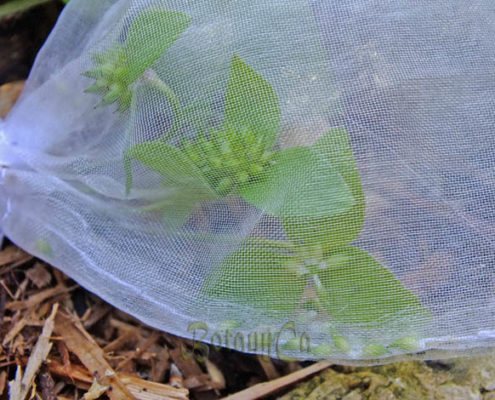

This is how you can simplify your seed collection @BotanyCa Seeds
It is easy to propagate the seeds of the liverwort noble, American, sharp-pointed and some non-double varietal liverworts (in this case, there is splitting by color).
Now read:
- Varieties of white peonies
- Ito varieties of peonies with photos and names
- The best varieties and hybrids of petunias - photo gallery (38 photos)
- Varieties of yellow peonies
- Tulips
There are difficulties in the process of obtaining seeds.In the conditions of the middle lane, it is better to pollinate plants by hand using a brush or cotton swab. It takes about a month from flowering to seed ripening (depending on the weather, more often by mid-June). Usually each flower produces 10-60 seeds.
Terry forms of seeds do not form, but in some flowers you can find a pistil (more often in Japanese) or stamens (in ordinary). You can use pollen of other varieties or species, or pollinate the non-double form with pollen obtained from a double flower.
Seed-grown liverworts will be better adapted to the climatic and soil conditions of your site.
Tips for planting liverwort seeds:
- Liverwort seeds quickly lose their germination. They can be stored in slightly damp vermiculite, perlite or sphagnum for up to six months.
- It is better to sow freshly harvested seeds in June-July, but in a dry year it is better to postpone sowing to the end of August.
- It is safer to sow in containers; in the ground, there is a high probability that the seeds or seedlings will be pulled apart by ants in the first two seasons.
Sow superficially, sprinkle with a small layer of sand, then pour lightly and cover with foil. During the first year, the plants develop poorly - the first true leaf grows only in the second year. Only in the third year can they be planted, in the fourth or seventh they will bloom.
Seedlings are planted in August of the first year or in the spring of the next year.
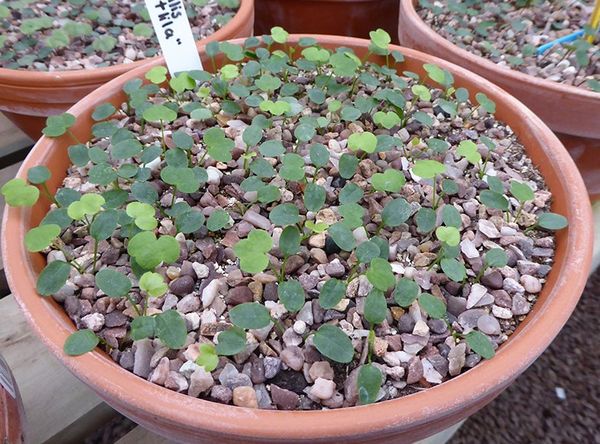

@John Massey VMH
According to the gardener Irina Efanova, by the color of the petioles in the second year, it is already possible to determine the color of the flowers. Light petioles are light flowers.
Division and grafting of the liverwort
Division most suitable for reproduction of terry liverworts, which cannot be grown from seeds. Although gardeners are happy to share other varieties as the bush grows.
It is recommended to do this every 4-5 years, in July-August or in spring, after flowering. In September, her root system is actively growing, so there will be good survival rate.
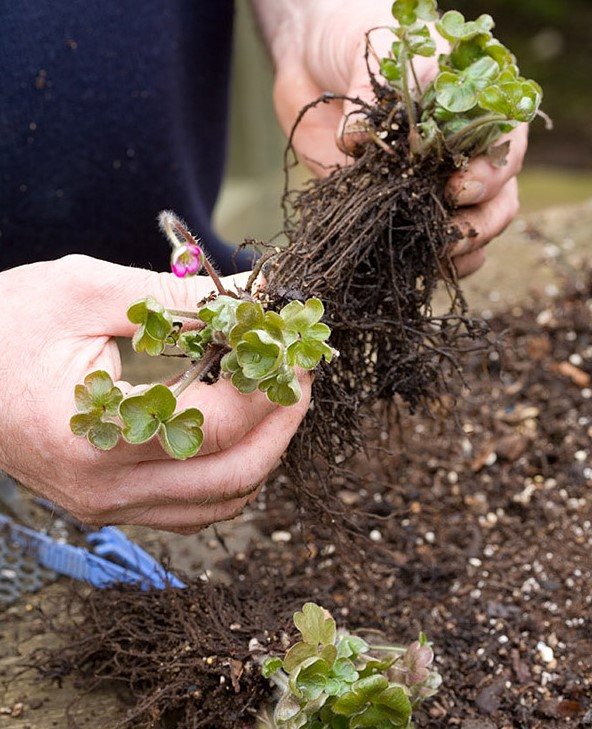

@John Massey VMH
Young plants can be seen by their characteristic leaves as early as 2 months after flowering.
How to share a coppice:
- The bush is dug up, washed and divided into divisions with two or three buds.
- Delenki are planted in loose, light, fertile soil in a shady place.
- When planting, the buds of renewal are not buried, they should be on the surface of the soil.
You can also get and cuttings, cutting off several pieces of rhizome with roots from each delenka. And it is very important that at the same time there is a part of the root collar.
There is another option: without digging a bush, scoop the ground off the roots and cut off a rosette or stalk from the side of the rhizome. It is desirable that 1-2 leaves remain.
- Hold the cutting in a growth stimulator or powder with "Kornevin".
- Plant in a container with a substrate under a cut plastic bottle, deepened by 1.5-2 cm.
When rooting, it is important to prevent the soil from drying out. The substrate for the pot is prepared from garden soil, leaf humus, peat and coarse sand (1: 2: 1: 1). After a couple of months, gradually remove the cover and plant the rooted cuttings in a permanent place.
Leaf and rosette cuttings without digging a plant are often used to propagate especially valuable plants that are undesirable to dig.
Video recommendations from Inga Bolkunova
Characteristics of the common liverwort plant (with photo)
According to its biological characteristics, the liverwort is a perennial herb up to 30 cm high. Its tubers are small, knobby, and in dry form they do not lose their viability for almost a whole year.


Stems are straight, strong, smooth or slightly pubescent, brown in color, weakly or unbranched.


The leaves are formed into a basal rosette, three-lobed, whole-edged, dense, leathery, fleecy below, purple at first, but gradually acquire a bright green color.Leaves change only with the onset of spring.


Flowers are solitary, cupped, blue, up to 4 cm in diameter, with narrow perianths of pink, blue, purple or white. They have no aroma. The copse blooms in April - May, one of the first blooms in the garden. Flowering occurs 3-4 years after planting. When observing the copse, you can notice that during the day its open flowers are directed upward, at night they close and droop.
After flowering, the fruit is formed - a rounded nut, which contains about 60 seeds.
The lifespan of a copse in a garden plot is about 20 years.
Plant care recommendations
The main rule: plant the liverwort according to all her needs, then there will be no problems in care in the future.
Watering in the spring once every 1-2 weeks, in the summer 1-2 times per season. Better from a watering can with a strainer.
Top dressing
A perennial does not need a lot of dressing. In early spring, you can feed on the snow with urea, and after flowering - with complex fertilizer.
Possible problems
Black spots may appear on the leaves in summer. This may be due to the dry and sunny location in which it grows. It is with a lack of moisture that dark spots may appear on the leaves, which then turn black and fall off. With properly adjusted care, this will not happen again.
In nature, the noble liverwort prefers to grow in moderately humid places, avoiding damp ones. She has several close relatives. One of them - Transylvanian - is very similar to the noble one, but the leaves have more blades, and they do not turn black. Although she also loves a wet area, but without stagnant water.
Wintering
In the fall, with the onset of cold weather, plantings are mulched with a small layer of leafy humus or neutral peat to protect flower buds that form right above the ground in case of snowless frosts.
Do not cut off old leaves in the fall if they are healthy - this reduces the winter hardiness of the plants.
In early spring, last year's leaves are cut off. Plant collector Svetlana Samoilova advises doing this when the plant blooms - so old leaves will not spoil the view.
Where to plant liverworms in the garden


When looking for a place for the liverwort in the garden, do not forget that its leaves will not die off in the summer, as in bulbous ones, they vegetate all season. This means that it should not be covered with large leaves of perennials that are still dormant.
These flowers look great as clumps of 10-15 plants. Plant the Transylvanian Corydalis and Siberian Kandyk next to the liverwort, you get a cheerful bright company that will revive the waking garden. Corydalis and kandyks after flowering will fall asleep until next spring, and the leaves of the liverwort will decorate the jacket.
The noble liverwort opens flowers a little later, when the oak and buttercup anemone, as well as the European kandyk and marigold are already blooming. Dwarf conifers and mountain goats will benefit from the neighborhood with bright flowers of the liverwort, and in the background you can plant hosts, sedges, ferns.
Liverworms are forest plants, so it is quite appropriate to plant them under trees. They love partial shade or even shade and loose, slightly acidic soils, in which there is a lot of leaf humus.
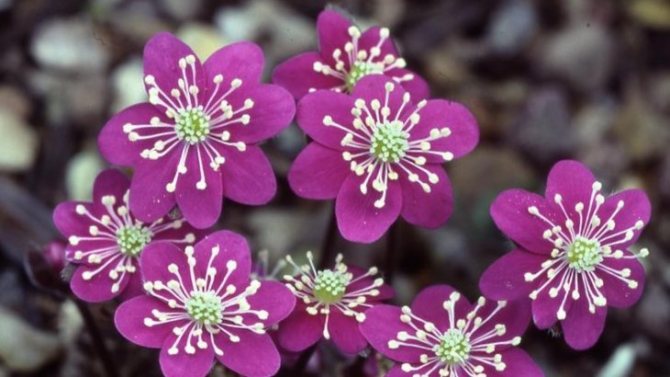

Liverworts will be grateful to the owners for mulch from needles, wood chips, small bark or leaf litter. These forest plants do not like bare soil, which dries quickly and compresses easily.
These flowers do not like excess moisture, therefore, it is necessary to water it only in drought, although they tolerate a couple of weeks of spring waterlogging, but no more.
For liverworms, you can make a raised flower bed under the trees, since their roots go shallowly into the ground, only up to 30 cm.
Beneficial features
The liverwort owes its name to the medieval belief that the appearance of a representative of the flora indicates which organ of a person can be treated with its help.
The three-lobed leaves of the liverwort are shaped like a liver, "hepar" in Greek.
The noble liverwort has been used in folk medicine for many years. The plant has anti-inflammatory, antiseptic, choleretic effect.
Leaf infusions are drunk for liver diseases, chronic bronchitis, skin diseases, enuresis, hepatitis, cholelithiasis, cystitis, bronchitis, tracheitis, rheumatism, gout, gonorrhea and internal bleeding.
Since ancient times, the herb of the liverwort was brewed like tea, it was rinsed with infusions of the oral cavity, and purulent wounds were washed.
Attention! The plant is poisonous. Care must be taken when taking liverwort drugs inside.
So you know.
The generic name of hepatica (Hepatica) is given to the plant for the trifoliate leaves, with their outlines resembling the shape of a human liver. The name of the liverwort is a direct tracing paper from Latin, but in the Russian people, the flower has long been called blue copse. This emphasized two of its features: azure-blue flowers, and the ability to grow only under the canopy of rare shrubs and in the thin shade of transparent deciduous trees.
In total, the genus liverwort has about a dozen species, common in the forest zone of the Northern Hemisphere. The most common is the noble liverwort (Hepatica nobilis), whose range covers most of Europe, including the European part of Russia.
Reproduction.
When the flower is in a single copy, the soul of the grower is in anxiety - what if it dies. Naturally, from the very beginning I wanted to turn my only blue copse into a whole field of flowering copse. The easiest way to reproduce is by division. But the liverwort grows slowly, the number of possible divisions does not exceed 3-4 pieces, and some of them inevitably fall out. Regarding seed reproduction, the book I have stated: "Seed reproduction is difficult, since the seeds fall unripe in the first half of June."
Suddenly, the liverwort herself suggested the method of reproduction. After the plant began to bloom stable, its seedlings began to appear next to it. I began to carefully transplant them to a special bed. Note that the mother plant itself was planted on loose moisture-absorbing light loamy soil in a light lateral penumbra. The foot of the flower, to facilitate self-seeding, was kept in a free state - under black steam. This increased the self-seeding efficiency. Most of the seedlings germinated in the immediate vicinity of the mother plant, but they often appeared at a considerable (up to 3 meters) distance, apparently carried by ants. By the way, scientific books on botany claim that the liverwort fruit has an oil-rich appendage that attracts ants, so the ant version of the spread of the liverwort is confirmed.
Thanks to the characteristic three-lobed leaves, the seedlings of the liverwort are clearly visible among other plants. Despite their miniature size, young seedlings have a fairly strong root and tolerate transplantation well. Soon they bloomed, and also began to give self-seeding, seedlings of the first generation. The process has begun.

